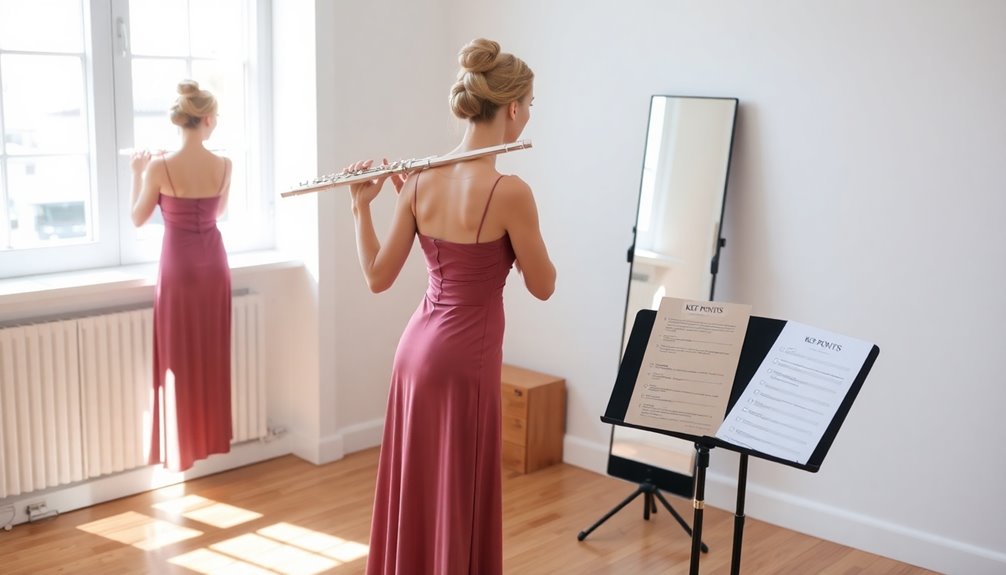To perfect your posture for better flute technique, start with your feet shoulder-width apart and knees relaxed. Engage your core gently to maintain the natural curve of your spine. Keep your arms comfortable, wrists straight, and head aligned with your spine, ensuring your chin is parallel to the floor. This alignment supports breath control, essential for producing a beautiful tone. Avoid common mistakes like slouching or gripping the flute too tightly, as they can hinder your progress. By making small adjustments now, you'll find significant improvements in no time—discover the exercises that can help you further enhance your posture.
Key Takeaways
- Maintain shoulder-width foot placement to establish a stable base for your flute playing.
- Keep your knees relaxed and align your hips with your shoulders for ideal posture.
- Engage your core gently to support the natural curve of your spine while playing.
- Ensure your arms are positioned comfortably with straight wrists to facilitate smooth flute grip.
- Align your head with the spine and keep your chin parallel to the floor for optimal airflow.
Importance of Good Posture

Good posture is the foundation of effective flute technique and can dramatically influence your playing. When you maintain good posture, you reveal a world of posture benefits that enhance your sound, improve your breath control, and reduce the risk of injury. You mightn't realize it, but the way you hold your body can directly impact the resonance of your notes and your overall performance.
Developing posture awareness is essential for every flutist. It helps you recognize when you're slouching or tensing up, allowing you to make adjustments that promote a more relaxed and efficient playing style.
By standing or sitting tall, with your shoulders back and your head aligned with your spine, you create an open pathway for air to flow, making it easier to produce a beautiful tone. Additionally, maintaining good posture supports diaphragmatic breathing, which enhances your overall breath control and tone quality.
Embracing good posture fosters a sense of belonging among fellow musicians, as you all aim for excellence together. When you prioritize your posture, you're not just improving your own playing; you're inspiring others in your community to do the same.
Basic Posture Checklist

Establishing a solid posture foundation is essential for any flutist, and having a basic checklist can guide you in achieving that.
Start by ensuring your feet are shoulder-width apart, providing a sturdy base. Keep your knees relaxed, avoiding tension, and align your hips with your shoulders for ideal posture alignment.
Next, engage your core gently; this will support your back as you maintain a natural curve. Your shoulders should be relaxed and down, not hunched.
Position your arms comfortably, ensuring your elbows are slightly away from your body and your wrists are straight, ready for a smooth flute grip.
As you hold your flute, make sure your fingers are curved and relaxed, enabling fluid movement across the keys. Your head should be aligned with your spine, keeping your chin parallel to the floor.
Finally, remember to breathe deeply; this will enhance your overall posture and technique. Consistently practicing with posture alignment tools can further support your efforts in maintaining proper form.
Standing vs. Sitting Position

Deciding whether to play while standing or sitting can greatly impact your flute technique and comfort. When you choose to stand, you gain several standing advantages. For one, standing often promotes better posture, allowing your body to align more naturally. This position can enhance your breath support and give you the freedom to move, making your performance feel more dynamic and expressive.
On the other hand, sitting can come with sitting disadvantages that might affect your playing. You may find it easy to slouch or become tense, which can hinder your airflow and limit your technique. Additionally, sitting for extended periods can lead to discomfort or fatigue, distracting you from your music.
Ultimately, it's crucial to experiment with both positions to see what feels best for you. Listen to your body and pay attention to how each position affects your playing. Incorporating ergonomic supports can further enhance your comfort and help maintain a balanced posture while playing.
Whether you prefer standing or sitting, the key is to maintain a balanced posture that supports your flute technique. Remember, there's no right or wrong choice; just find what helps you feel confident and connected to your music.
Breath Control and Alignment

Effective breath control is essential for mastering flute technique, and it starts with proper alignment. When you stand or sit up straight, you create an open pathway for your breath, allowing you to engage your diaphragm effectively. This alignment not only supports your sound production but also helps you maintain steady airflow, which is vital for producing a beautiful tone.
To enhance your breath support, focus on your diaphragm engagement. As you inhale, feel your abdomen expand rather than your chest. This deep breathing technique allows your lungs to fill fully, providing the support you need while playing.
When you exhale, aim for a controlled release of air, which helps sustain your notes and phrases. Incorporating breath control exercises into your daily practice can further improve your performance and sound quality.
Common Posture Mistakes

Even with proper breath control and alignment, many flutists unknowingly fall into common posture mistakes that can hinder their technique. One of the most frequent pitfalls is slouching or leaning too far forward. This not only affects your sound but also puts unnecessary strain on your back. Instead, focus on maintaining a straight spine and relaxed shoulders, which is key for fluid playing.
Another mistake is gripping the flute too tightly. This tension can lead to discomfort and restrict your movement. Aim for a gentle, supportive hold that allows for natural finger motion.
Additionally, neglecting posture awareness can lead to misaligned wrists. Pay attention to alignment cues, ensuring your wrists are level with the flute, not bent or twisted.
Lastly, don't forget about your feet! Standing with your weight shifted to one side can throw off your balance. Keep your feet shoulder-width apart and evenly distribute your weight. Incorporating core engagement techniques will further support your posture and enhance your breath control while playing.
Exercises for Better Posture

To enhance your posture for flute playing, incorporating specific exercises into your routine can make a significant difference.
Start with core engagement exercises, as a strong core supports your entire body. Try planks or bridges to activate your abdominal muscles. These not only strengthen your core but also improve your stability while playing.
Next, focus on alignment awareness by practicing wall angels. Stand with your back against a wall, feet slightly away from it. Raise your arms to form a "W" shape against the wall, then slowly slide them up to form a "Y." This exercise promotes proper shoulder alignment, which is vital for good flute technique.
You can also do seated pelvic tilts. Sit at the edge of a chair, feet flat on the ground. Gently rock your pelvis back and forth, feeling the movement in your lower back. This helps you develop a better sense of spinal alignment.
Consistency is key! Incorporate these exercises into your daily practice routine.
As you become more aware of your posture, you'll find it easier to play with confidence and improve your overall performance. Articulation techniques are also influenced by your physical posture, allowing for clearer and more expressive playing. You're not just practicing; you're building a stronger foundation for your musical journey!
Stretching and Strengthening Tips

Many flutists overlook the importance of stretching and strengthening their bodies, but these practices are essential for enhancing performance. Incorporating dynamic stretches into your warm-up routine can greatly improve your flexibility and range of motion.
Try arm circles, torso twists, and leg swings before you start playing. These movements not only prepare your muscles but also energize your body, setting a positive tone for your practice session.
In addition to stretching, focus on core strengthening exercises. A strong core stabilizes your posture, allowing you to hold the flute with ease and confidence. Regular maintenance practices can also enhance your overall playing experience by ensuring that your instrument remains in top shape.
Simple exercises like planks, bridges, and seated leg raises can be done anywhere, making them easy to fit into your daily routine. Aim for consistency; even just a few minutes a day can yield noticeable results over time.
Integrating Posture Into Practice

When you practice, integrating proper posture can make a significant difference in your flute technique. By developing posture awareness and using alignment cues, you can enhance your sound and reduce tension. Here are some simple steps to help you focus on your posture during practice:
| Alignment Cues | Posture Awareness Tips |
|---|---|
| Stand tall | Relax your shoulders |
| Feet shoulder-width | Distribute your weight evenly |
| Engage your core | Keep your head aligned with your spine |
| Flute at chin level | Maintain a relaxed grip |
| Breathe deeply | Check your reflection regularly |
Begin each practice session by checking in with your body. Are you standing or sitting comfortably? Make adjustments as needed. Remember, small changes can lead to big improvements. As you play, continue to remind yourself of those alignment cues. Listening to your body and adjusting your posture will not only help you sound better but will also create a more enjoyable playing experience. You're part of a community of musicians who support each other in this journey. Embrace it, and keep refining your posture for the best results! Additionally, maintaining proper posture supports breath control and enhances your overall tone production.
Frequently Asked Questions
How Does Poor Posture Affect My Flute Sound Quality?
Poor posture can really impact your flute sound quality.
When you slouch or hunch, it restricts your breath support, making it harder to produce a full, rich tone. You might notice your tone quality suffers, sounding weak or airy.
By standing tall and aligning your body properly, you can improve your airflow and resonance.
Can Posture Influence My Flute Playing Speed?
Your posture plays an essential role in your flute playing speed.
When you sit or stand correctly, you enhance your breath control, allowing for smoother airflow. This helps you maintain consistent sound while playing faster passages.
Plus, good posture supports finger agility, letting your fingers move swiftly and accurately across the keys.
Is There a Specific Posture for Different Flute Types?
Absolutely, different flute types can require specific posture adjustments.
For instance, when playing a concert flute, you'll want to hold it parallel to the floor, ensuring your shoulders are relaxed.
In contrast, for a piccolo, you might need to raise your elbows slightly.
These small adjustments can enhance your comfort and playing efficiency.
Embrace these changes; they'll help you feel more connected to your instrument and your fellow musicians!
How Often Should I Check My Posture While Playing?
You might think checking your posture is only for yoga classes, but it's essential for playing, too!
During regular practice, set up posture reminders to glance at yourself every few minutes. It helps to make certain you're not turning into a pretzel while trying to hit that high note.
Can Posture Improvements Help Reduce Playing-Related Injuries?
Absolutely, improving your posture can play an essential role in injury prevention.
When you adopt ergonomic practices, you distribute tension more evenly throughout your body, which helps minimize strain. Regularly checking and adjusting your posture while playing can make a big difference.
Conclusion
In the symphony of flute playing, good posture is your conductor, guiding every note you play. By focusing on your alignment and making small adjustments, you'll reveal a world of improved technique and sound. Remember, practice makes perfect—integrate these tips into your routine, and soon, proper posture will feel as natural as breathing. Embrace the changes, and watch your confidence soar as you create beautiful music with ease and grace!






